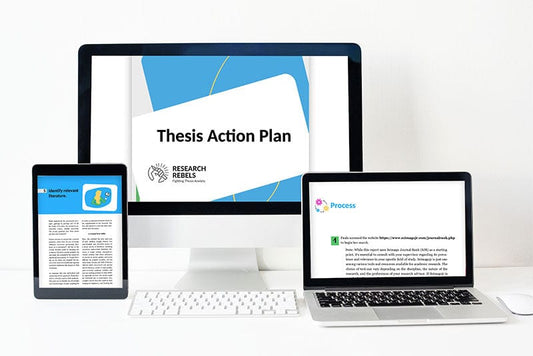How to Write Your Thesis This Week: Your 7-Day Emergency Plan

Got a thesis deadline looming and only a week to pull it together? Don’t panic. It might sound impossible, but with a solid plan and a bit of grit, you can get it done. This guide breaks down exactly what you need to do each day to tackle your thesis efficiently. Forget perfection—focus on progress. Let’s dive in.
Key Takeaways
- Break your thesis into smaller, manageable parts to avoid feeling overwhelmed.
- Set daily goals and stick to a consistent writing schedule.
- Use credible sources and keep your references well-organized.
- Write a clear and concise methodology section to strengthen your thesis.
- Edit thoroughly and ask for feedback before submission.
Breaking Down the Thesis Writing Process
Understanding the Core Components of a Thesis
Writing a thesis can feel like assembling a complex puzzle, but understanding its core parts simplifies the task. A thesis typically includes an introduction, literature review, methodology, results, discussion, and conclusion. Each section serves a specific purpose:
- Introduction: Sets the stage by presenting your research question and objectives.
- Literature Review: Summarizes existing research and identifies gaps your study addresses.
- Methodology: Explains how you conducted your research.
- Results: Presents your findings.
- Discussion: Interprets the results and ties them back to your research question.
- Conclusion: Wraps up your study and suggests future research directions.
Knowing these components helps you plan your writing and stay organized. Focus on one section at a time to avoid feeling overwhelmed.
The Importance of a Clear Research Question
Your research question is the backbone of your thesis. It guides your study and ensures your work stays focused. A good research question should be specific, relevant to your field, and feasible within your timeline. For example:
| Weak Question | Strong Question |
|---|---|
| What are the effects of climate change? | How does climate change impact crop yields in the Midwest? |
Spending time refining your question is worth it. A well-defined question keeps your research on track and makes your thesis more compelling.
How to Structure Your Thesis Effectively
A clear structure is key to a readable thesis. Start with an outline to map out your ideas. Here’s a simple structure to follow:
- Title Page: Includes your thesis title, name, and institution.
- Abstract: Summarizes your study in 200-300 words.
- Table of Contents: Lists all sections and page numbers.
- Main Body: Divided into the sections discussed earlier.
- References: Lists all sources cited in your work.
- Appendices: Includes supplementary material like raw data or questionnaires.
Stick to your institution’s formatting guidelines to avoid last-minute headaches. A structured approach not only helps you but also makes it easier for readers to follow your argument.
Creating a Manageable Daily Writing Schedule
Setting Realistic Daily Goals
Writing your thesis in a week can feel like a Herculean task, but breaking it into smaller, daily goals makes it achievable. The key is to aim for progress, not perfection. Start by dividing your thesis into sections—introduction, literature review, methodology, results, discussion, and conclusion. Assign each section to a specific day and set a word count target. For instance:
| Day | Task | Word Count Goal |
|---|---|---|
| Day 1 | Introduction | 1,000 |
| Day 2 | Literature Review | 2,000 |
| Day 3 | Methodology | 1,500 |
| Day 4 | Results | 1,500 |
| Day 5 | Discussion | 2,000 |
| Day 6 | Conclusion & Abstract | 1,000 |
| Day 7 | Editing & Formatting | N/A |
Adjust the plan based on your writing speed and the complexity of each section. Remember, it’s better to set a modest goal and exceed it than to overcommit and fall behind.
Incorporating Breaks to Maintain Focus
Writing for hours on end without a break is a recipe for burnout. Try the Pomodoro Technique—work for 25 minutes, then take a 5-minute break. After four cycles, take a longer 15-30 minute break. Use this time to stretch, hydrate, or grab a snack. Short breaks help reset your focus and keep your energy levels up throughout the day.
Tracking Progress to Stay Motivated
Keep a simple log to track your daily achievements. Write down what you accomplished each day—whether it’s hitting your word count or completing a draft of a section. Seeing your progress in black and white can be incredibly motivating. If you’re feeling stuck, remind yourself of the bigger picture: finishing your thesis this week. For more strategies on staying organized and productive, check out effective strategies to write a high-quality thesis.
Mastering Research and Literature Review
Finding Credible Sources Efficiently
When you're scrambling to finish your thesis in a week, finding credible sources can feel overwhelming. Here's the trick: focus on quality, not quantity. Start with academic databases like PubMed, JSTOR, or Google Scholar. If you're targeting industry-specific insights, platforms like LinkedIn can sometimes lead you to white papers or expert opinions. Use keywords strategically and set filters to narrow down the results. Don't waste time on sources that don't directly support your argument.
Organizing Your References Systematically
A disorganized reference list is a nightmare when you're on a deadline. Tools like Zotero or EndNote can save you hours. Create folders for each chapter or section of your thesis, and assign tags for quick searches later. Here's a simple table to help you track your references manually if you're not into software:
| Source Title | Author | Year | Relevance to Thesis |
|---|---|---|---|
| Example Study 1 | Dr. Smith | 2020 | Supports Methodology |
| Example Study 2 | Prof. Lee | 2018 | Contrasts Argument |
Synthesizing Information for Your Argument
Now comes the challenging part: making sense of all the information you've gathered. Don't just list what others have said. Instead, compare and contrast different viewpoints. Ask yourself: How does this source support my thesis? Does it highlight a gap in the research? By synthesizing rather than summarizing, your literature review will feel cohesive and purposeful. Remember, the goal is to show that you understand the field and where your work fits into it.
Crafting a Strong Methodology Section
Choosing the Right Research Design
The research design is the backbone of your methodology section. It determines how you approach your study and ensures that your findings are meaningful. Start by identifying whether your study is qualitative, quantitative, or mixed-methods. This choice should align with your research question and objectives. For example, if you're exploring individual experiences, a qualitative approach might be best. On the other hand, if you're analyzing numerical data, you'll likely lean toward a quantitative design. Always justify your choice, explaining why it's the most appropriate for your work.
Addressing Ethical Considerations
Ethics in research isn't just a formality; it’s a responsibility. You need to show that your study respects participants' rights and adheres to institutional and legal guidelines. Some key points to cover include:
- Obtaining informed consent from participants.
- Ensuring confidentiality and anonymity.
- Minimizing potential harm or discomfort.
If your study involves vulnerable populations, outline the extra steps you’ll take to protect them. Remember, ethical approval from your institution's review board is often mandatory.
Presenting Your Methods Clearly
Clarity is everything in the methods section. Readers should understand exactly how you conducted your research so they can evaluate its validity. Use straightforward language and avoid unnecessary jargon. A good structure might include:
- Participants or Subjects: Describe who or what you studied, including sample size and selection criteria.
- Materials or Instruments: List the tools, surveys, or equipment you used, and explain why they were chosen.
- Procedure: Detail the steps you followed, from data collection to analysis.
For example, if you conducted interviews, mention how many, how long they lasted, and how they were recorded and transcribed. If you used a survey, discuss how it was distributed and the response rate. Tables can be helpful here to summarize key details, such as participant demographics or experimental conditions.
Polishing Your Thesis for Submission
Editing for Clarity and Consistency
When you’re nearing the finish line, it’s time to focus on making your thesis as clear and consistent as possible. Start by reading through each section with fresh eyes. Are your arguments easy to follow? Are your transitions smooth? Make sure your language is concise and free of unnecessary jargon. A good trick is to read your work out loud—it can help you catch awkward phrasing or repetitive ideas.
Here’s a quick checklist to guide your edits:
- Double-check for typos and grammatical errors.
- Ensure that all sections follow a logical flow.
- Confirm that your terminology is consistent throughout the document.
Formatting According to Guidelines
Formatting might not be the most exciting part of writing a thesis, but it’s absolutely critical. Universities often have strict rules about margins, font size, citation styles, and even page numbering. Pull up your institution’s formatting guide and go through it line by line. Don’t underestimate how much time this step can take.
Common formatting tasks include:
- Setting up a title page that meets the requirements.
- Ensuring all tables and figures are labeled correctly.
- Verifying that your bibliography matches the required citation style.
Seeking Feedback from Advisors and Peers
Even the best writers need a second pair of eyes. Share your thesis with your advisor, committee members, or even a trusted peer. Be open to constructive criticism—it’s all part of the process. If you’re active on platforms like Instagram, consider joining academic communities there to get quick tips or moral support. Just remember, feedback is a tool to make your work stronger, not a personal critique.
Pro Tip: Give your reviewers enough time to go through your work. A rushed review might miss important details that could improve your thesis.
Overcoming Common Thesis Writing Challenges
Dealing with Writer’s Block
Writer’s block is one of the most frustrating hurdles in thesis writing. It’s that moment when your brain feels like it’s hit a wall, and words just won’t come out. To combat this, start by breaking your writing into smaller, manageable tasks. For example, instead of saying, “I’ll write the methodology today,” try, “I’ll write the first two sentences of the methodology.” Sometimes, starting small is all you need to get the momentum going.
Another trick is to switch gears. If you’re stuck on one section, move to another. You could even take a short break to clear your mind—just make sure it doesn’t turn into a full day of procrastination. Finally, remember that a bad draft is better than no draft. You can always edit later.
Managing Time Effectively
Time management can make or break your thesis-writing week. Begin by creating a realistic schedule. Divide your time into blocks for writing, research, and breaks. A simple table like this might help:
| Task | Time Allotted |
|---|---|
| Write Introduction | 2 hours |
| Research Sources | 1 hour |
| Take a Break | 30 minutes |
| Edit Draft | 1.5 hours |
Stick to your schedule as closely as possible, but don’t beat yourself up if you fall behind. Adjust as needed and keep moving forward. Also, try to eliminate distractions—turn off notifications and let others know you’re unavailable during your writing blocks.
Staying Motivated Under Pressure
When the pressure’s on, staying motivated can feel impossible. One way to keep your spirits up is to remind yourself why you’re doing this. Whether it’s for a degree, a career goal, or personal achievement, keep that purpose front and center.
Reward yourself for small wins. Completed a section? Treat yourself to a snack or a quick walk. Finished a full chapter? Maybe that’s coffee with a friend. Motivation doesn’t have to come from big milestones—it’s the little victories that keep you going.
Finally, don’t hesitate to lean on your support system. Talk to a friend, join a study group, or even seek guidance from your advisor. As highlighted in this guide, having a structured and supportive plan can significantly reduce stress and help you stay on track.
Leveraging Support Systems for Success

Utilizing Academic Resources
When you're knee-deep in thesis writing, it's easy to forget the wealth of resources your university offers. Think of academic advisors, writing centers, and even library workshops. These are all designed to help you, so don't hesitate to use them. Writing centers, for example, can help fine-tune your arguments or clarify muddled sections. Your advisors are there to guide you, so make sure to schedule regular check-ins. And don’t overlook library workshops—they often teach research hacks that save hours of frustration.
Engaging with Peer Support Groups
Sometimes, the best help comes from people who are in the same boat as you. Peer support groups, whether formal or informal, can be a game-changer. Set up a small group chat on WhatsApp to share updates, ask questions, or even vent when things get tough. These groups can keep you motivated and accountable. Plus, hearing how others tackle similar challenges can spark ideas you hadn’t considered. You might even find a study buddy who helps you stick to your goals.
Seeking Professional Coaching or Mentorship
If you’re feeling stuck, professional help can make a world of difference. Many universities offer mentorship programs where experienced faculty guide you through the thesis process. Alternatively, you can look into professional coaching services. These coaches specialize in helping students overcome hurdles like procrastination or writer’s block. It’s not about doing the work for you—it’s about giving you the tools to succeed. Think of it as an investment in your academic future.
Using support systems can really help you succeed. Whether it's friends, family, or mentors, having people to lean on makes a big difference. If you're feeling lost or stressed, don't hesitate to reach out for help. You don't have to do it alone! For more tips and resources, visit our website and see how we can support you on your journey!
Conclusion
Writing a thesis in just one week is no small feat, but with the right plan and mindset, it’s absolutely possible. By breaking the process into manageable daily tasks, staying focused, and using proven strategies, you can make significant progress without feeling overwhelmed. Remember, this is about progress, not perfection. Stick to your schedule, take breaks when needed, and trust the process. At the end of the week, you’ll not only have a completed thesis but also the satisfaction of knowing you tackled a major challenge head-on. Good luck—you’ve got this!
Frequently Asked Questions
Can I really write a thesis in just one week?
Yes, it’s possible with a clear plan and focus. Break your work into smaller tasks, stick to a daily schedule, and avoid distractions to make steady progress.
What should I do if I get stuck while writing?
Take a short break, revisit your outline, or discuss your ideas with someone who can offer feedback. Sometimes stepping away for a moment helps you gain clarity.
How do I find credible sources quickly?
Use trusted databases like Google Scholar, JSTOR, or your school’s library. Look for peer-reviewed articles and books written by experts in your field.
What’s the best way to stay motivated during this process?
Set small, achievable goals each day. Celebrate your progress, no matter how small, and remind yourself of the bigger picture—your thesis completion.
How can I ensure my thesis meets formatting guidelines?
Review your school’s thesis guidelines carefully. Use templates if available and double-check formatting before submission to avoid last-minute stress.
Should I ask for feedback before submitting my thesis?
Absolutely! Share your draft with advisors, peers, or mentors. Their feedback can help you improve the clarity and quality of your work.
How to Write Your Thesis This Week: Your 7-Day Emergency Plan

Got a thesis deadline looming and only a week to pull it together? Don’t panic. It might sound impossible, but with a solid plan and a bit of grit, you can get it done. This guide breaks down exactly what you need to do each day to tackle your thesis efficiently. Forget perfection—focus on progress. Let’s dive in.
Key Takeaways
- Break your thesis into smaller, manageable parts to avoid feeling overwhelmed.
- Set daily goals and stick to a consistent writing schedule.
- Use credible sources and keep your references well-organized.
- Write a clear and concise methodology section to strengthen your thesis.
- Edit thoroughly and ask for feedback before submission.
Breaking Down the Thesis Writing Process
Understanding the Core Components of a Thesis
Writing a thesis can feel like assembling a complex puzzle, but understanding its core parts simplifies the task. A thesis typically includes an introduction, literature review, methodology, results, discussion, and conclusion. Each section serves a specific purpose:
- Introduction: Sets the stage by presenting your research question and objectives.
- Literature Review: Summarizes existing research and identifies gaps your study addresses.
- Methodology: Explains how you conducted your research.
- Results: Presents your findings.
- Discussion: Interprets the results and ties them back to your research question.
- Conclusion: Wraps up your study and suggests future research directions.
Knowing these components helps you plan your writing and stay organized. Focus on one section at a time to avoid feeling overwhelmed.
The Importance of a Clear Research Question
Your research question is the backbone of your thesis. It guides your study and ensures your work stays focused. A good research question should be specific, relevant to your field, and feasible within your timeline. For example:
| Weak Question | Strong Question |
|---|---|
| What are the effects of climate change? | How does climate change impact crop yields in the Midwest? |
Spending time refining your question is worth it. A well-defined question keeps your research on track and makes your thesis more compelling.
How to Structure Your Thesis Effectively
A clear structure is key to a readable thesis. Start with an outline to map out your ideas. Here’s a simple structure to follow:
- Title Page: Includes your thesis title, name, and institution.
- Abstract: Summarizes your study in 200-300 words.
- Table of Contents: Lists all sections and page numbers.
- Main Body: Divided into the sections discussed earlier.
- References: Lists all sources cited in your work.
- Appendices: Includes supplementary material like raw data or questionnaires.
Stick to your institution’s formatting guidelines to avoid last-minute headaches. A structured approach not only helps you but also makes it easier for readers to follow your argument.
Creating a Manageable Daily Writing Schedule
Setting Realistic Daily Goals
Writing your thesis in a week can feel like a Herculean task, but breaking it into smaller, daily goals makes it achievable. The key is to aim for progress, not perfection. Start by dividing your thesis into sections—introduction, literature review, methodology, results, discussion, and conclusion. Assign each section to a specific day and set a word count target. For instance:
| Day | Task | Word Count Goal |
|---|---|---|
| Day 1 | Introduction | 1,000 |
| Day 2 | Literature Review | 2,000 |
| Day 3 | Methodology | 1,500 |
| Day 4 | Results | 1,500 |
| Day 5 | Discussion | 2,000 |
| Day 6 | Conclusion & Abstract | 1,000 |
| Day 7 | Editing & Formatting | N/A |
Adjust the plan based on your writing speed and the complexity of each section. Remember, it’s better to set a modest goal and exceed it than to overcommit and fall behind.
Incorporating Breaks to Maintain Focus
Writing for hours on end without a break is a recipe for burnout. Try the Pomodoro Technique—work for 25 minutes, then take a 5-minute break. After four cycles, take a longer 15-30 minute break. Use this time to stretch, hydrate, or grab a snack. Short breaks help reset your focus and keep your energy levels up throughout the day.
Tracking Progress to Stay Motivated
Keep a simple log to track your daily achievements. Write down what you accomplished each day—whether it’s hitting your word count or completing a draft of a section. Seeing your progress in black and white can be incredibly motivating. If you’re feeling stuck, remind yourself of the bigger picture: finishing your thesis this week. For more strategies on staying organized and productive, check out effective strategies to write a high-quality thesis.
Mastering Research and Literature Review
Finding Credible Sources Efficiently
When you're scrambling to finish your thesis in a week, finding credible sources can feel overwhelming. Here's the trick: focus on quality, not quantity. Start with academic databases like PubMed, JSTOR, or Google Scholar. If you're targeting industry-specific insights, platforms like LinkedIn can sometimes lead you to white papers or expert opinions. Use keywords strategically and set filters to narrow down the results. Don't waste time on sources that don't directly support your argument.
Organizing Your References Systematically
A disorganized reference list is a nightmare when you're on a deadline. Tools like Zotero or EndNote can save you hours. Create folders for each chapter or section of your thesis, and assign tags for quick searches later. Here's a simple table to help you track your references manually if you're not into software:
| Source Title | Author | Year | Relevance to Thesis |
|---|---|---|---|
| Example Study 1 | Dr. Smith | 2020 | Supports Methodology |
| Example Study 2 | Prof. Lee | 2018 | Contrasts Argument |
Synthesizing Information for Your Argument
Now comes the challenging part: making sense of all the information you've gathered. Don't just list what others have said. Instead, compare and contrast different viewpoints. Ask yourself: How does this source support my thesis? Does it highlight a gap in the research? By synthesizing rather than summarizing, your literature review will feel cohesive and purposeful. Remember, the goal is to show that you understand the field and where your work fits into it.
Crafting a Strong Methodology Section
Choosing the Right Research Design
The research design is the backbone of your methodology section. It determines how you approach your study and ensures that your findings are meaningful. Start by identifying whether your study is qualitative, quantitative, or mixed-methods. This choice should align with your research question and objectives. For example, if you're exploring individual experiences, a qualitative approach might be best. On the other hand, if you're analyzing numerical data, you'll likely lean toward a quantitative design. Always justify your choice, explaining why it's the most appropriate for your work.
Addressing Ethical Considerations
Ethics in research isn't just a formality; it’s a responsibility. You need to show that your study respects participants' rights and adheres to institutional and legal guidelines. Some key points to cover include:
- Obtaining informed consent from participants.
- Ensuring confidentiality and anonymity.
- Minimizing potential harm or discomfort.
If your study involves vulnerable populations, outline the extra steps you’ll take to protect them. Remember, ethical approval from your institution's review board is often mandatory.
Presenting Your Methods Clearly
Clarity is everything in the methods section. Readers should understand exactly how you conducted your research so they can evaluate its validity. Use straightforward language and avoid unnecessary jargon. A good structure might include:
- Participants or Subjects: Describe who or what you studied, including sample size and selection criteria.
- Materials or Instruments: List the tools, surveys, or equipment you used, and explain why they were chosen.
- Procedure: Detail the steps you followed, from data collection to analysis.
For example, if you conducted interviews, mention how many, how long they lasted, and how they were recorded and transcribed. If you used a survey, discuss how it was distributed and the response rate. Tables can be helpful here to summarize key details, such as participant demographics or experimental conditions.
Polishing Your Thesis for Submission
Editing for Clarity and Consistency
When you’re nearing the finish line, it’s time to focus on making your thesis as clear and consistent as possible. Start by reading through each section with fresh eyes. Are your arguments easy to follow? Are your transitions smooth? Make sure your language is concise and free of unnecessary jargon. A good trick is to read your work out loud—it can help you catch awkward phrasing or repetitive ideas.
Here’s a quick checklist to guide your edits:
- Double-check for typos and grammatical errors.
- Ensure that all sections follow a logical flow.
- Confirm that your terminology is consistent throughout the document.
Formatting According to Guidelines
Formatting might not be the most exciting part of writing a thesis, but it’s absolutely critical. Universities often have strict rules about margins, font size, citation styles, and even page numbering. Pull up your institution’s formatting guide and go through it line by line. Don’t underestimate how much time this step can take.
Common formatting tasks include:
- Setting up a title page that meets the requirements.
- Ensuring all tables and figures are labeled correctly.
- Verifying that your bibliography matches the required citation style.
Seeking Feedback from Advisors and Peers
Even the best writers need a second pair of eyes. Share your thesis with your advisor, committee members, or even a trusted peer. Be open to constructive criticism—it’s all part of the process. If you’re active on platforms like Instagram, consider joining academic communities there to get quick tips or moral support. Just remember, feedback is a tool to make your work stronger, not a personal critique.
Pro Tip: Give your reviewers enough time to go through your work. A rushed review might miss important details that could improve your thesis.
Overcoming Common Thesis Writing Challenges
Dealing with Writer’s Block
Writer’s block is one of the most frustrating hurdles in thesis writing. It’s that moment when your brain feels like it’s hit a wall, and words just won’t come out. To combat this, start by breaking your writing into smaller, manageable tasks. For example, instead of saying, “I’ll write the methodology today,” try, “I’ll write the first two sentences of the methodology.” Sometimes, starting small is all you need to get the momentum going.
Another trick is to switch gears. If you’re stuck on one section, move to another. You could even take a short break to clear your mind—just make sure it doesn’t turn into a full day of procrastination. Finally, remember that a bad draft is better than no draft. You can always edit later.
Managing Time Effectively
Time management can make or break your thesis-writing week. Begin by creating a realistic schedule. Divide your time into blocks for writing, research, and breaks. A simple table like this might help:
| Task | Time Allotted |
|---|---|
| Write Introduction | 2 hours |
| Research Sources | 1 hour |
| Take a Break | 30 minutes |
| Edit Draft | 1.5 hours |
Stick to your schedule as closely as possible, but don’t beat yourself up if you fall behind. Adjust as needed and keep moving forward. Also, try to eliminate distractions—turn off notifications and let others know you’re unavailable during your writing blocks.
Staying Motivated Under Pressure
When the pressure’s on, staying motivated can feel impossible. One way to keep your spirits up is to remind yourself why you’re doing this. Whether it’s for a degree, a career goal, or personal achievement, keep that purpose front and center.
Reward yourself for small wins. Completed a section? Treat yourself to a snack or a quick walk. Finished a full chapter? Maybe that’s coffee with a friend. Motivation doesn’t have to come from big milestones—it’s the little victories that keep you going.
Finally, don’t hesitate to lean on your support system. Talk to a friend, join a study group, or even seek guidance from your advisor. As highlighted in this guide, having a structured and supportive plan can significantly reduce stress and help you stay on track.
Leveraging Support Systems for Success

Utilizing Academic Resources
When you're knee-deep in thesis writing, it's easy to forget the wealth of resources your university offers. Think of academic advisors, writing centers, and even library workshops. These are all designed to help you, so don't hesitate to use them. Writing centers, for example, can help fine-tune your arguments or clarify muddled sections. Your advisors are there to guide you, so make sure to schedule regular check-ins. And don’t overlook library workshops—they often teach research hacks that save hours of frustration.
Engaging with Peer Support Groups
Sometimes, the best help comes from people who are in the same boat as you. Peer support groups, whether formal or informal, can be a game-changer. Set up a small group chat on WhatsApp to share updates, ask questions, or even vent when things get tough. These groups can keep you motivated and accountable. Plus, hearing how others tackle similar challenges can spark ideas you hadn’t considered. You might even find a study buddy who helps you stick to your goals.
Seeking Professional Coaching or Mentorship
If you’re feeling stuck, professional help can make a world of difference. Many universities offer mentorship programs where experienced faculty guide you through the thesis process. Alternatively, you can look into professional coaching services. These coaches specialize in helping students overcome hurdles like procrastination or writer’s block. It’s not about doing the work for you—it’s about giving you the tools to succeed. Think of it as an investment in your academic future.
Using support systems can really help you succeed. Whether it's friends, family, or mentors, having people to lean on makes a big difference. If you're feeling lost or stressed, don't hesitate to reach out for help. You don't have to do it alone! For more tips and resources, visit our website and see how we can support you on your journey!
Conclusion
Writing a thesis in just one week is no small feat, but with the right plan and mindset, it’s absolutely possible. By breaking the process into manageable daily tasks, staying focused, and using proven strategies, you can make significant progress without feeling overwhelmed. Remember, this is about progress, not perfection. Stick to your schedule, take breaks when needed, and trust the process. At the end of the week, you’ll not only have a completed thesis but also the satisfaction of knowing you tackled a major challenge head-on. Good luck—you’ve got this!
Frequently Asked Questions
Can I really write a thesis in just one week?
Yes, it’s possible with a clear plan and focus. Break your work into smaller tasks, stick to a daily schedule, and avoid distractions to make steady progress.
What should I do if I get stuck while writing?
Take a short break, revisit your outline, or discuss your ideas with someone who can offer feedback. Sometimes stepping away for a moment helps you gain clarity.
How do I find credible sources quickly?
Use trusted databases like Google Scholar, JSTOR, or your school’s library. Look for peer-reviewed articles and books written by experts in your field.
What’s the best way to stay motivated during this process?
Set small, achievable goals each day. Celebrate your progress, no matter how small, and remind yourself of the bigger picture—your thesis completion.
How can I ensure my thesis meets formatting guidelines?
Review your school’s thesis guidelines carefully. Use templates if available and double-check formatting before submission to avoid last-minute stress.
Should I ask for feedback before submitting my thesis?
Absolutely! Share your draft with advisors, peers, or mentors. Their feedback can help you improve the clarity and quality of your work.
How to Write Your Thesis This Week: Your 7-Day Emergency Plan

Got a thesis deadline looming and only a week to pull it together? Don’t panic. It might sound impossible, but with a solid plan and a bit of grit, you can get it done. This guide breaks down exactly what you need to do each day to tackle your thesis efficiently. Forget perfection—focus on progress. Let’s dive in.
Key Takeaways
- Break your thesis into smaller, manageable parts to avoid feeling overwhelmed.
- Set daily goals and stick to a consistent writing schedule.
- Use credible sources and keep your references well-organized.
- Write a clear and concise methodology section to strengthen your thesis.
- Edit thoroughly and ask for feedback before submission.
Breaking Down the Thesis Writing Process
Understanding the Core Components of a Thesis
Writing a thesis can feel like assembling a complex puzzle, but understanding its core parts simplifies the task. A thesis typically includes an introduction, literature review, methodology, results, discussion, and conclusion. Each section serves a specific purpose:
- Introduction: Sets the stage by presenting your research question and objectives.
- Literature Review: Summarizes existing research and identifies gaps your study addresses.
- Methodology: Explains how you conducted your research.
- Results: Presents your findings.
- Discussion: Interprets the results and ties them back to your research question.
- Conclusion: Wraps up your study and suggests future research directions.
Knowing these components helps you plan your writing and stay organized. Focus on one section at a time to avoid feeling overwhelmed.
The Importance of a Clear Research Question
Your research question is the backbone of your thesis. It guides your study and ensures your work stays focused. A good research question should be specific, relevant to your field, and feasible within your timeline. For example:
| Weak Question | Strong Question |
|---|---|
| What are the effects of climate change? | How does climate change impact crop yields in the Midwest? |
Spending time refining your question is worth it. A well-defined question keeps your research on track and makes your thesis more compelling.
How to Structure Your Thesis Effectively
A clear structure is key to a readable thesis. Start with an outline to map out your ideas. Here’s a simple structure to follow:
- Title Page: Includes your thesis title, name, and institution.
- Abstract: Summarizes your study in 200-300 words.
- Table of Contents: Lists all sections and page numbers.
- Main Body: Divided into the sections discussed earlier.
- References: Lists all sources cited in your work.
- Appendices: Includes supplementary material like raw data or questionnaires.
Stick to your institution’s formatting guidelines to avoid last-minute headaches. A structured approach not only helps you but also makes it easier for readers to follow your argument.
Creating a Manageable Daily Writing Schedule
Setting Realistic Daily Goals
Writing your thesis in a week can feel like a Herculean task, but breaking it into smaller, daily goals makes it achievable. The key is to aim for progress, not perfection. Start by dividing your thesis into sections—introduction, literature review, methodology, results, discussion, and conclusion. Assign each section to a specific day and set a word count target. For instance:
| Day | Task | Word Count Goal |
|---|---|---|
| Day 1 | Introduction | 1,000 |
| Day 2 | Literature Review | 2,000 |
| Day 3 | Methodology | 1,500 |
| Day 4 | Results | 1,500 |
| Day 5 | Discussion | 2,000 |
| Day 6 | Conclusion & Abstract | 1,000 |
| Day 7 | Editing & Formatting | N/A |
Adjust the plan based on your writing speed and the complexity of each section. Remember, it’s better to set a modest goal and exceed it than to overcommit and fall behind.
Incorporating Breaks to Maintain Focus
Writing for hours on end without a break is a recipe for burnout. Try the Pomodoro Technique—work for 25 minutes, then take a 5-minute break. After four cycles, take a longer 15-30 minute break. Use this time to stretch, hydrate, or grab a snack. Short breaks help reset your focus and keep your energy levels up throughout the day.
Tracking Progress to Stay Motivated
Keep a simple log to track your daily achievements. Write down what you accomplished each day—whether it’s hitting your word count or completing a draft of a section. Seeing your progress in black and white can be incredibly motivating. If you’re feeling stuck, remind yourself of the bigger picture: finishing your thesis this week. For more strategies on staying organized and productive, check out effective strategies to write a high-quality thesis.
Mastering Research and Literature Review
Finding Credible Sources Efficiently
When you're scrambling to finish your thesis in a week, finding credible sources can feel overwhelming. Here's the trick: focus on quality, not quantity. Start with academic databases like PubMed, JSTOR, or Google Scholar. If you're targeting industry-specific insights, platforms like LinkedIn can sometimes lead you to white papers or expert opinions. Use keywords strategically and set filters to narrow down the results. Don't waste time on sources that don't directly support your argument.
Organizing Your References Systematically
A disorganized reference list is a nightmare when you're on a deadline. Tools like Zotero or EndNote can save you hours. Create folders for each chapter or section of your thesis, and assign tags for quick searches later. Here's a simple table to help you track your references manually if you're not into software:
| Source Title | Author | Year | Relevance to Thesis |
|---|---|---|---|
| Example Study 1 | Dr. Smith | 2020 | Supports Methodology |
| Example Study 2 | Prof. Lee | 2018 | Contrasts Argument |
Synthesizing Information for Your Argument
Now comes the challenging part: making sense of all the information you've gathered. Don't just list what others have said. Instead, compare and contrast different viewpoints. Ask yourself: How does this source support my thesis? Does it highlight a gap in the research? By synthesizing rather than summarizing, your literature review will feel cohesive and purposeful. Remember, the goal is to show that you understand the field and where your work fits into it.
Crafting a Strong Methodology Section
Choosing the Right Research Design
The research design is the backbone of your methodology section. It determines how you approach your study and ensures that your findings are meaningful. Start by identifying whether your study is qualitative, quantitative, or mixed-methods. This choice should align with your research question and objectives. For example, if you're exploring individual experiences, a qualitative approach might be best. On the other hand, if you're analyzing numerical data, you'll likely lean toward a quantitative design. Always justify your choice, explaining why it's the most appropriate for your work.
Addressing Ethical Considerations
Ethics in research isn't just a formality; it’s a responsibility. You need to show that your study respects participants' rights and adheres to institutional and legal guidelines. Some key points to cover include:
- Obtaining informed consent from participants.
- Ensuring confidentiality and anonymity.
- Minimizing potential harm or discomfort.
If your study involves vulnerable populations, outline the extra steps you’ll take to protect them. Remember, ethical approval from your institution's review board is often mandatory.
Presenting Your Methods Clearly
Clarity is everything in the methods section. Readers should understand exactly how you conducted your research so they can evaluate its validity. Use straightforward language and avoid unnecessary jargon. A good structure might include:
- Participants or Subjects: Describe who or what you studied, including sample size and selection criteria.
- Materials or Instruments: List the tools, surveys, or equipment you used, and explain why they were chosen.
- Procedure: Detail the steps you followed, from data collection to analysis.
For example, if you conducted interviews, mention how many, how long they lasted, and how they were recorded and transcribed. If you used a survey, discuss how it was distributed and the response rate. Tables can be helpful here to summarize key details, such as participant demographics or experimental conditions.
Polishing Your Thesis for Submission
Editing for Clarity and Consistency
When you’re nearing the finish line, it’s time to focus on making your thesis as clear and consistent as possible. Start by reading through each section with fresh eyes. Are your arguments easy to follow? Are your transitions smooth? Make sure your language is concise and free of unnecessary jargon. A good trick is to read your work out loud—it can help you catch awkward phrasing or repetitive ideas.
Here’s a quick checklist to guide your edits:
- Double-check for typos and grammatical errors.
- Ensure that all sections follow a logical flow.
- Confirm that your terminology is consistent throughout the document.
Formatting According to Guidelines
Formatting might not be the most exciting part of writing a thesis, but it’s absolutely critical. Universities often have strict rules about margins, font size, citation styles, and even page numbering. Pull up your institution’s formatting guide and go through it line by line. Don’t underestimate how much time this step can take.
Common formatting tasks include:
- Setting up a title page that meets the requirements.
- Ensuring all tables and figures are labeled correctly.
- Verifying that your bibliography matches the required citation style.
Seeking Feedback from Advisors and Peers
Even the best writers need a second pair of eyes. Share your thesis with your advisor, committee members, or even a trusted peer. Be open to constructive criticism—it’s all part of the process. If you’re active on platforms like Instagram, consider joining academic communities there to get quick tips or moral support. Just remember, feedback is a tool to make your work stronger, not a personal critique.
Pro Tip: Give your reviewers enough time to go through your work. A rushed review might miss important details that could improve your thesis.
Overcoming Common Thesis Writing Challenges
Dealing with Writer’s Block
Writer’s block is one of the most frustrating hurdles in thesis writing. It’s that moment when your brain feels like it’s hit a wall, and words just won’t come out. To combat this, start by breaking your writing into smaller, manageable tasks. For example, instead of saying, “I’ll write the methodology today,” try, “I’ll write the first two sentences of the methodology.” Sometimes, starting small is all you need to get the momentum going.
Another trick is to switch gears. If you’re stuck on one section, move to another. You could even take a short break to clear your mind—just make sure it doesn’t turn into a full day of procrastination. Finally, remember that a bad draft is better than no draft. You can always edit later.
Managing Time Effectively
Time management can make or break your thesis-writing week. Begin by creating a realistic schedule. Divide your time into blocks for writing, research, and breaks. A simple table like this might help:
| Task | Time Allotted |
|---|---|
| Write Introduction | 2 hours |
| Research Sources | 1 hour |
| Take a Break | 30 minutes |
| Edit Draft | 1.5 hours |
Stick to your schedule as closely as possible, but don’t beat yourself up if you fall behind. Adjust as needed and keep moving forward. Also, try to eliminate distractions—turn off notifications and let others know you’re unavailable during your writing blocks.
Staying Motivated Under Pressure
When the pressure’s on, staying motivated can feel impossible. One way to keep your spirits up is to remind yourself why you’re doing this. Whether it’s for a degree, a career goal, or personal achievement, keep that purpose front and center.
Reward yourself for small wins. Completed a section? Treat yourself to a snack or a quick walk. Finished a full chapter? Maybe that’s coffee with a friend. Motivation doesn’t have to come from big milestones—it’s the little victories that keep you going.
Finally, don’t hesitate to lean on your support system. Talk to a friend, join a study group, or even seek guidance from your advisor. As highlighted in this guide, having a structured and supportive plan can significantly reduce stress and help you stay on track.
Leveraging Support Systems for Success

Utilizing Academic Resources
When you're knee-deep in thesis writing, it's easy to forget the wealth of resources your university offers. Think of academic advisors, writing centers, and even library workshops. These are all designed to help you, so don't hesitate to use them. Writing centers, for example, can help fine-tune your arguments or clarify muddled sections. Your advisors are there to guide you, so make sure to schedule regular check-ins. And don’t overlook library workshops—they often teach research hacks that save hours of frustration.
Engaging with Peer Support Groups
Sometimes, the best help comes from people who are in the same boat as you. Peer support groups, whether formal or informal, can be a game-changer. Set up a small group chat on WhatsApp to share updates, ask questions, or even vent when things get tough. These groups can keep you motivated and accountable. Plus, hearing how others tackle similar challenges can spark ideas you hadn’t considered. You might even find a study buddy who helps you stick to your goals.
Seeking Professional Coaching or Mentorship
If you’re feeling stuck, professional help can make a world of difference. Many universities offer mentorship programs where experienced faculty guide you through the thesis process. Alternatively, you can look into professional coaching services. These coaches specialize in helping students overcome hurdles like procrastination or writer’s block. It’s not about doing the work for you—it’s about giving you the tools to succeed. Think of it as an investment in your academic future.
Using support systems can really help you succeed. Whether it's friends, family, or mentors, having people to lean on makes a big difference. If you're feeling lost or stressed, don't hesitate to reach out for help. You don't have to do it alone! For more tips and resources, visit our website and see how we can support you on your journey!
Conclusion
Writing a thesis in just one week is no small feat, but with the right plan and mindset, it’s absolutely possible. By breaking the process into manageable daily tasks, staying focused, and using proven strategies, you can make significant progress without feeling overwhelmed. Remember, this is about progress, not perfection. Stick to your schedule, take breaks when needed, and trust the process. At the end of the week, you’ll not only have a completed thesis but also the satisfaction of knowing you tackled a major challenge head-on. Good luck—you’ve got this!
Frequently Asked Questions
Can I really write a thesis in just one week?
Yes, it’s possible with a clear plan and focus. Break your work into smaller tasks, stick to a daily schedule, and avoid distractions to make steady progress.
What should I do if I get stuck while writing?
Take a short break, revisit your outline, or discuss your ideas with someone who can offer feedback. Sometimes stepping away for a moment helps you gain clarity.
How do I find credible sources quickly?
Use trusted databases like Google Scholar, JSTOR, or your school’s library. Look for peer-reviewed articles and books written by experts in your field.
What’s the best way to stay motivated during this process?
Set small, achievable goals each day. Celebrate your progress, no matter how small, and remind yourself of the bigger picture—your thesis completion.
How can I ensure my thesis meets formatting guidelines?
Review your school’s thesis guidelines carefully. Use templates if available and double-check formatting before submission to avoid last-minute stress.
Should I ask for feedback before submitting my thesis?
Absolutely! Share your draft with advisors, peers, or mentors. Their feedback can help you improve the clarity and quality of your work.














